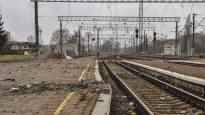Transporting Western weapons aid by rail increases Russia’s desire to strike the Ukrainian railway network, an expert from the National Defense College said.
Russia’s attacks on the Ukrainian railways are very likely to become more widespread in the future, the military professor estimates Janne Mäkitalo About the National Defense College.
On Monday, Russia hit five railway stations in western and central Ukraine. Russia’s defense ministry has admitted, according to the news agency Reuters, that the attacks were aimed at preventing foreign arms supplies from entering the front by destroying Ukraine’s railway network.
– The probability of an increase in attacks is very high, because Western weapons aid has increased and its type has changed, Mäkitalo says by phone.
Mäkitalo says that in the past, reasonably easy equipment was brought to Ukraine from the west, such as shackles and anti-tank and anti-aircraft missiles. The equipment now being transported is heavier, such as battle tanks and armored vehicles, so moving them by train is the only sensible option.
The heavier the fleet, the more important the railways for Ukraine. At the same time, according to Mäkitalo, the railways are becoming a more important target for attacks in Russia.
– Russia does not want to strike material warehouses or railways on the Polish side, so the logical consequence is that it feels the right to strike Ukrainian rail transport and the railways themselves, says Mäkitalo.
Russia could also have benefited from the railway network
The railways have also traditionally been an important route for the Russian army in moving equipment. In Ukraine, the railway gauge is the same as in Russia, so it would have been possible for Russia to make significant use of the Ukrainian railway network.
Railways connect major cities and industrial plants in Ukraine. Because Russian forces have failed to take over, or at least occupy, these hub cities, they have not been able to travel any further along the railways.
Mäkitalo, a military professor, believes that Russia would have wanted to use the railways.
– The logistics maintenance and replenishment of the Russian armed forces are based almost exclusively on the use of the railways. The material flows are so huge.
According to Mäkitalo, the desire to take advantage of the railways explains, at least in part, why Russian forces have not hit the railways in the northern, eastern and southern parts of the country hard. Previous attacks on railway junctions and trains have mainly taken place in central and western Ukraine.
Mäkitalo also highlights the attack on Kramatorsk railway station in eastern Ukraine in early April, which killed at least 50 people. The attack received extensive negative publicity in the West, which, according to Mäkitalo, may also explain the fact that no similar attacks have taken place in recent weeks.
Mäkitalo commented on ‘s morning just over a week ago that in eastern Ukraine, Russian troops were interested in taking over the railways.
Troops have faced adversity, but there are still rail links between and along the attack wedges that are key to servicing the Donbass.
According to Mäkitalo, it is no coincidence that the attacks are heading west towards Kramatorsk. If Russia takes over the territories all the way to Kramatorsk, the sections of track that are key to the vitality of Donbass will be in Russia’s possession.
– It enables the safe maintenance of their armed forces.
Attacks on bridges, logistics centers and control systems worst
If Russian troops strike the ordinary railways, the impact may not be huge. Repairing an ordinary railway is a relatively simple task for a professional, Mäkitalo says.
However, if Russian forces begin to strike railroad bridges, logistics centers, or rail traffic control systems, the consequences will be different and repairs will take longer.
In addition to arms transport, trains have been important for travel in Ukraine. Millions of people have been evacuated, especially in the early stages of the war, and train travel still seems to be considered a relatively safe form of travel in the country – at least compared to other options.
Since the beginning of the war, the leadership of various countries has relied on railway safety. Among other things, the US Secretary of State Antony Blinken and the Minister of Defense Lloyd Austin visited Kiev on Sunday, and according to Reuters news agency, they traveled there by train.
According to Mäkitalo, there is always a risk involved in traveling by train in Ukraine.
– There is a similar risk if people use main roads. Unfortunately, a lot has been seen in ordinary civilian vehicles, against which the Russian armed forces have used firepower and caused civilian losses, recalls military professor Janne Mäkitalo.
